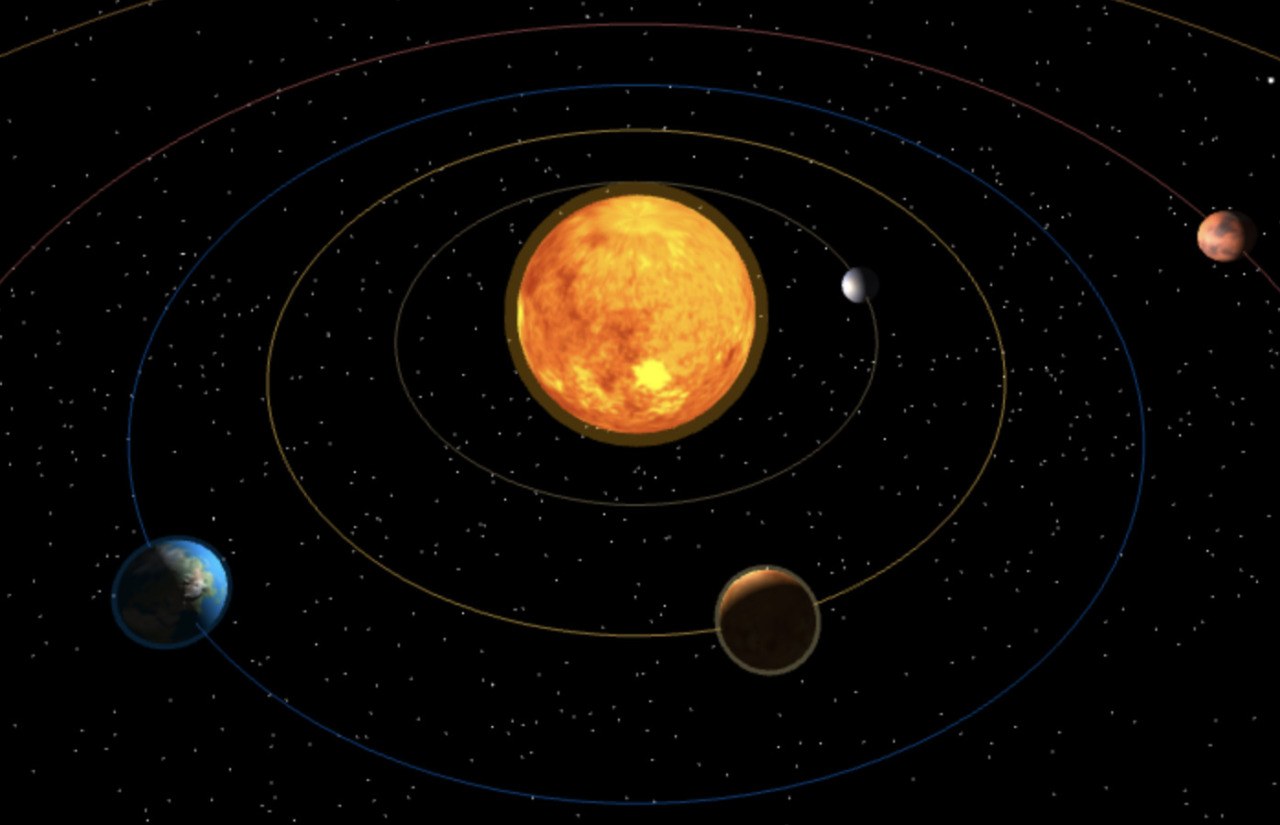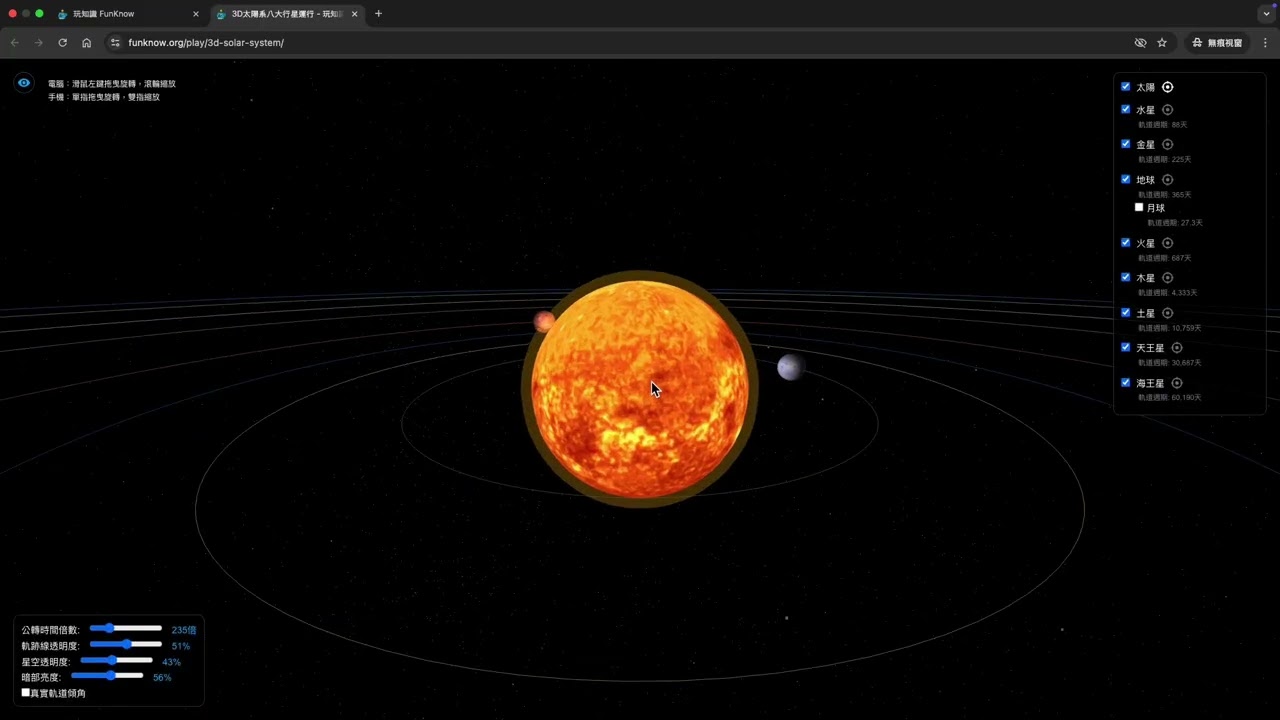Step into the vast universe and experience an amazing 3D solar system adventure! This immersive planetary motion simulator brings you up close to the magnificent spectacle of our solar system, from the blazing Sun to distant Neptune, with every planet vividly rendered before your eyes.
✨ Unique Features:
- Realistic Scale Simulation: Presents planetary sizes and orbital distances based on actual celestial proportions
- Dynamic Lighting Effects: The Sun radiates warm light with vivid planetary surface details
- Free-form View Control: 360-degree observation from any angle you desire
- Time Speed Adjustment: From slow observation to fast demonstration, control the flow of time
- Customizable Display: Toggle any celestial body on or off to focus on what interests you
Whether you’re an astronomy enthusiast, educator, or simply someone curious about the universe, this simulator will open a gateway to cosmic mysteries. Making science engaging and learning enjoyable!
User Guide
Basic Controls
- Rotate View: Left-click and drag with mouse or single-finger swipe on mobile
- Zoom: Mouse wheel or pinch-to-zoom on mobile
- Center View: Click the center icon next to planet names on the right panel to switch planet-locked view
Left Control Panel Functions
- Orbital Time Multiplier: Adjust planetary motion speed (1-1000x)
- Orbit Trail Opacity: Control the visibility of orbital paths
- Starfield Opacity: Adjust background starfield brightness
- Shadow Brightness: Change the brightness of planetary shadow sides
- Real Orbital Inclination: When enabled, displays actual orbital tilt angles of planets
Display Options
The right panel allows individual control of each celestial body’s visibility:
- ☀️ Sun: The central star of our solar system
- 🌍 Planets: Mercury, Venus, Earth, Mars, Jupiter, Saturn, Uranus, Neptune
- 🌙 Moon: Earth’s natural satellite
Hide All Interface
Click the eye icon in the top-left corner to hide all control panels and enjoy a pure stargazing experience.
Solar System Celestial Bodies
☀️ The Sun
The central star of our solar system, around which all planets orbit.
- Type: G-type main-sequence star
- Diameter: Approximately 1.39 million km (109 times Earth’s diameter)
- Surface Temperature: Approximately 5,500°C
- Features: Provides all energy for the solar system, has powerful magnetic fields and solar wind
☿️ Mercury
The closest planet to the Sun, with a surface covered in impact craters.
- Diameter: 4,879 km (0.38 times Earth’s diameter)
- Orbital Period: 88 days
- Rotation Period: 59 days
- Features: Extreme temperature variations, reaching 427°C during the day and -173°C at night, with virtually no atmosphere
♀️ Venus
Known as the “Morning Star” or “Evening Star,” it’s the brightest planet in the night sky.
- Diameter: 12,104 km (0.95 times Earth’s diameter)
- Orbital Period: 225 days
- Rotation Period: 243 days (retrograde rotation)
- Features: Surface temperature reaches 462°C, has a thick carbon dioxide atmosphere with atmospheric pressure 90 times that of Earth
🌍 Earth
Our home planet, the only known planet in the solar system to harbor life.
- Diameter: 12,756 km
- Orbital Period: 365.25 days
- Rotation Period: 24 hours
- Features: 71% of surface covered by oceans, has a life-supporting atmosphere and protective magnetic field
🌙 The Moon
Earth’s only natural satellite, influencing Earth’s tidal changes.
- Diameter: 3,474 km (0.27 times Earth’s diameter)
- Orbital Period: 27.3 days
- Distance from Earth: Average 380,000 km
- Features: Always shows the same face to Earth, surface features prominent craters and dark regions
♂️ Mars
The Red Planet, a candidate destination for future human colonization.
- Diameter: 6,792 km (0.53 times Earth’s diameter)
- Orbital Period: 687 days
- Rotation Period: 24 hours 37 minutes
- Features: Home to the solar system’s largest volcano (Olympus Mons) and canyons, with water ice covering the polar regions
♃ Jupiter
The largest planet in our solar system, king of the gas giants.
- Diameter: 142,984 km (11.2 times Earth’s diameter)
- Orbital Period: 11.9 years (4,333 days)
- Rotation Period: 9 hours 55 minutes
- Features: Has over 80 moons including the four major Galilean moons, famous for the Great Red Spot storm that has persisted for hundreds of years
♄ Saturn
The beautiful planet with spectacular ring systems.
- Diameter: 120,536 km (9.4 times Earth’s diameter)
- Orbital Period: 29.5 years (10,759 days)
- Rotation Period: 10 hours 33 minutes
- Features: Less dense than water, has complex ring systems, largest moon Titan has a thick atmosphere
♅ Uranus
The sideways-spinning ice giant with a unique rotational axis.
- Diameter: 51,118 km (4 times Earth’s diameter)
- Orbital Period: 84 years (30,687 days)
- Rotation Period: 17 hours 14 minutes
- Features: Rotational axis tilted at 98 degrees, essentially rolling on its side, has faint ring systems and 27 known moons
♆ Neptune
The outermost major planet in our solar system, the world with the fastest winds.
- Diameter: 49,528 km (3.9 times Earth’s diameter)
- Orbital Period: 165 years (60,190 days)
- Rotation Period: 16 hours 6 minutes
- Features: Wind speeds can reach 2,100 km/hour, has dynamic atmospheric conditions and 14 known moons
Educational Value
This 3D solar system simulator is not only visually stunning but also carries significant educational importance:
Target Audience
- Students: Supplementary material for elementary and secondary astronomy science courses
- Educators: Classroom demonstration and interactive teaching tool
- Astronomy Enthusiasts: Deep understanding of solar system structure and orbital mechanics
- General Public: Cultivating scientific interest and cosmic awareness
Learning Outcomes
- Visual Learning: Concrete presentation of abstract astronomical concepts
- Scale Comprehension: Intuitive understanding of planetary size and distance relationships
- Time Perception: Understanding different planetary orbital periods through time acceleration features
- Spatial Thinking: Developing three-dimensional spatial imagination abilities
Knowledge Extension
- Astronomy Fundamentals: Understanding basic solar system structure and composition
- Physics Concepts: Gravity, orbits, rotation and revolution, and other fundamental physical phenomena
- Mathematical Applications: Practical application of mathematical concepts like ratios, periods, and angles
- Scientific Exploration: Inspiring curiosity about the universe and science
Disclaimer
Educational Purpose Statement
This 3D solar system planetary motion simulator is intended for educational and learning purposes only. The simulation content is based on current astronomical scientific knowledge and data, but for visual effects and educational convenience, some proportions and details may have been adjusted.
Accuracy Statement
- Scale Adjustments: For visual presentation purposes, planetary sizes, orbital distances, and other proportions may differ from actual conditions
- Simplified Processing: Complex celestial orbital motions have been simplified; actual celestial movements are more complex
- Data Updates: Astronomical data is continuously being updated; some information may not be the latest version

